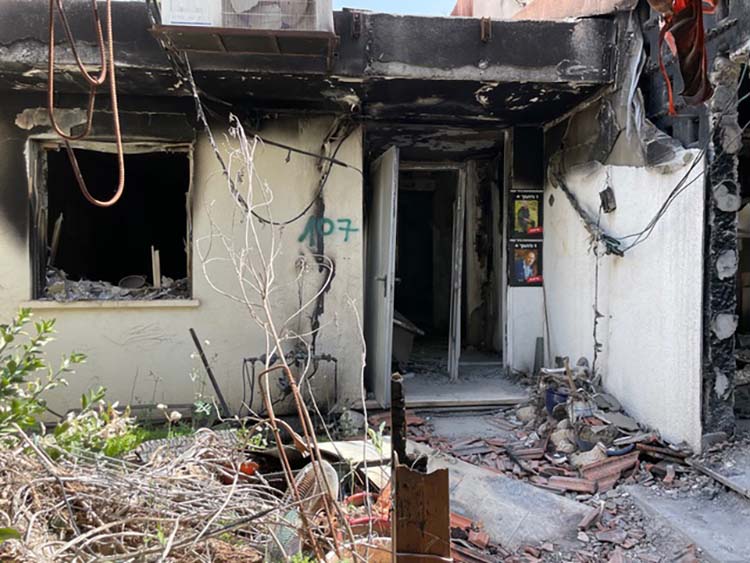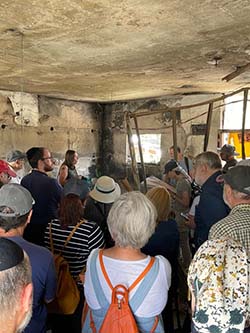
By Steve Kramer


KFAR SABA, Israel –Israel’s war against Hamas is not yet over. Either Israel will capitulate to Hamas to retrieve its remaining 59 captives, alive and dead, or the war will continue until Hamas is effectively eliminated. But if Israel stops fighting and leaves Gaza, and if Hamas actually hands over our captives, then Israel will have lost the war, having sustained more than 2,000 civilian and military deaths. Hamas will still run Gaza, it won’t have lost any territory, and most of its population will remain.
With this situation as background, earlier this week Michal and I returned to Israel’s south. We joined an IDSF trip to the Gaza Envelope, which we had visited last November. IDSF stands for Israel’s Defense and Security Forum. Founded in 2020 by (Reserve) Brigadier-General Amir Avivi, it is known as the most influential movement in Israel in all matters related to national security. It is supported across the board by many Israelis, most – but not all – are situated on the right politically.
Its mission: We are a Zionist, security-based movement, whose aim is to position Israel’s security as the top national priority, in a manner which ensures the sovereignty of the Jewish people in their homeland for generations to come.
Our understanding of Israel’s security inherently includes actively countering antisemitism and anti-Israel propaganda, recognizing these as direct threats to the legitimacy and security of the State of Israel.
This was a much more detailed and personal trip than our initial one, because it was led not by a professional guide but by Tal Nir, a leader of the IDSF who, himself, is a reserve Lieutenant Colonel. We again visited the horrendous “parking lot” containing hundreds of ruined vehicles destroyed by Hamas during its onslaught on October 7, 2023. Our guide at the site, Dagnit Bar-Chai, is a “local” who knew some of the slaughtered victims. She explained to us that the endemic Arab culture does not just desire to kill Jews, but to desecrate and incinerate Jewish bodies after killing them.
Accelerants added to their ammunition, especially rocket propelled grenades (rpg) created heat reaching thousands of degrees! That’s why so many of the bodies were not identified for months, after the most novel methods were used in the process. It was almost like they were cremated. At one point, archeologists were called in for their expertise in identifying ancient remains, which some of the body parts resembled.
Our second stop was the religious moshav Tkuma, which was established on the night of October 5, 1946 as one of 11 points in the Negev. This was a plan to establish eleven “points” of Jewish settlement in the Negev desert, to assure a Jewish presence in the area prior to the partition of Palestine. Up to that point, the Negev had been designated to be part of a generic Arab state. These hastily erected “facts on the ground” led to the Negev’s inclusion in the area allocated to Jews by the 1947 UN Partition Plan for Palestine.
Note: this strategy was similar to the 1947 Tower and Stockade settlements constructed overnight in northern Israel.
We were hosted in Tkuma by Ronit Farkash, head of the Municipal Committee. Ronit has lived in Tkuma for decades. At the age of 4, Ronit and her family made Aliyah from the US just one year before every Israeli was evacuated from Gaza (obviously a horrendous, ill-conceived decision). We were seated in her backyard, which was set up for groups like ours.
Along with many other communities in the Gaza Envelope, Tkuma’s defensive weapons were removed in the years leading up to 10/7. Why? Because the IDF believed that the chance of a terrorist incursion, after the erection of the hi-tech border fence, was ‘close to nil.’ Not only that: IDF forces were removed from the area, leaving local security as the last line of defense, dependent on their personal weapons. Obviously the security team was in a poor position to defend the moshav when the attack started. Only after two days were IDF armaments supplied to them! (Now weapons are again stored at Tkuma.)
At the time of the attack (6:30 am) Ronit was walking her dogs far from her home. When she heard nearby firing, she sheltered in the closest house until she could return home. Because Tkuma is a religious community, its main entrance gate was locked for Shabbat and the holiday of Simchat Torah. The pedestrian gate was also locked because of numerous robberies by Arabs who would prey on homes where the families were away. Because of this, Tkuma was spared the worst of it, in spite of the fact that most families do not use the phone on Shabbat and holidays.
Ronit’s daughter Shai, a naval commander, was off the coast that morning in a small Dvora-class (Bumblebee) fast patrol boat. She told us that she and her fighters were able to kill scores of marine invaders whose rubber boats had been sunk by a navy ship, leaving the terrorists no opportunity to survive except to swim towards shore. They didn’t make it.
While fighting in Gaza, Ronit’s son was hit in the hand by a sniper while his bullet-proof vest saved him. He returned to duty prematurely (not uncommon behavior) to continue to fight with his unit in Rafah. That’s how it goes….
(Read a full interview with Ronit written just two weeks after 10/7.)
We next went to Kibbutz Nir Oz, the community where 117 out of its 400 residents were either kidnapped or murdered. Our guide, Rita Lifschitz, came to Nir Oz in 1955 and knew everyone. She proceeded to lead our group on a remarkable 90-minute tour of the kibbutz, where all but a handful of homes were utterly wrecked by terrorists and will be replaced. Like Tkuma, Nir Oz was used to rocket attacks, but never an attack like this.
We walked down the still beautiful lanes, marred only by the vast destruction. Many of the kibbutz’s hostages have not been freed. We constantly heard booms from nearby Gaza, caused not by terrorists, but by the IDF rooting out terrorists and destroying tunnels and buildings, ALL of which had hidden materiel or tunnel entrances.
On October 7, the kibbutz, just a short distance from the border with Gaza, was invaded by hundreds of Hamas terrorists and ‘civilian’ terrorists as well. Many Gazans were originally employed here, where kibbutzniks who sympathized with their plight gave them jobs and often ferried sick Gazans to Israeli hospitals. Our guide’s father-in-law, 83-year-old peace activist Oded Lifshitz, was taken hostage on October 7, 2023, from Kibbutz Nir Oz and slain in captivity.
The Bibas family was abducted from Nir Oz. Shiri, a young mother clutching her red-haired infant Kfir and her toddler Ariel, was proudly live-streamed by her captors as she was taken down a once peaceful, beautiful path. Shiri and her children were imagined by Israelis to still be alive, even after Hamas declared they were not. It was nearly impossible that they would be murdered in cold blood; but they were…. Was there an outcry over this atrocity other than in Israel? When their bodies were returned, did a storm of outrage erupt against Hamas? If so, I never heard about it. Shiri’s husband, Yarden Bibas, was abducted separately and released into Israel on January 1, 2025, vainly hoping that he would be reunited with his family.
As Rita took us inside half a dozen of the ruined homes we picked our way through the debris, including broken windows and walls, ruined appliances, destroyed clothes, pots, pans, cushions, books, televisions, and everything that made a dwelling into a home. While we walked we heard Rita’s constant refrain, “he was murdered here on the 7th of October”, “she was murdered here on the 7th of October,” … and on and on. “We are the refugees of Israel,” Rita concluded.
Fourteen Nir Oz kibbutz members are still captive in Gaza. Not one Gazan has said a word about where our captives are hidden. Not one in a population of perhaps two million. These are not people who deserve a home anywhere near Israelis, whom they will never stop trying to kill and exterminate. Westerners must harden their hearts against these jihadists. Kidnapping cannot become a standard way for terrorists to win wars!
After lunch and a short delay to fix a bus problem, we entered Sderot, the largest and closest city to Gaza. It was founded in 1951 as a transit camp for Jewish immigrants; 80 families from Kurdistan and Iran were the first residents. The development was designed as part of a chain of settlements guarding the border with Gaza. 74 years later, the town’s population has swelled to nearly 40,000, with many sabras joining new immigrants who call Sderot their home – even as Sderot has a history of frequent rocket attacks.
On October 7 the town was overrun by Hamas terrorists, as described to us by Berta, a local resident who lives close to the main target, the police station. The Times of Israel reported, “On the morning of October 7, 2023, 41 Palestinian terrorists invaded the southern city of Sderot, located less than a mile from the border with the Gaza Strip, amid the Hamas-led onslaught, murdering dozens of civilians and police officers. Nearly 1,000 Israeli security forces ended up in Sderot, a city of 38,000 residents, on October 7, as terrorists were abducting and massacring hundreds of civilians and numerous smaller communities close to the border, where troops reached hours later.”
We all stood in the memorial park honoring the police men and women who were killed. On that terrible day Berta could hear terrorists and fighting from her apartment. She even saw some terrorists lurking around the neighborhood the next day! After more than a day of horrendous fighting, the terrorists were defeated. A new police station has been built in town and the original site honors the many victims who died in Sderot on October 7 and 8.
From there, we made our way back north. We thank the IDSF, a meritorious organization fighting Israel’s enemies and educating Israelis to recognize our Jihadist Muslim adversaries. We will surely join more IDSF tours, whose leader, General Amir Avivi, has become a respected voice for a stronger, more vigilant Israel.
*
Steve Kramer is a freelance writer based in Kfar Saba, Israel.